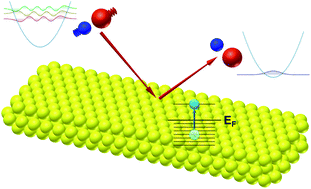Energy transfer at metal surfaces: the need to go beyond the electronic friction picture
Abstract
Interactions of molecules at metal surfaces can result in energy exchange with the electrons of the metal. This complicates theoretical strategies designed to simulate surface reactivity, most of which today are based on the Born–Oppenheimer approximation. One widely applied electronically nonadiabatic theory designed to make the leap beyond the Born–Oppenheimer approximation is “molecular dynamics with electronic friction”, where weak coupling of adsorbate motion to metal electrons is treated as a frictional force field modifying the molecular dynamics in a systematic and simple way. This minireview describes recent experiments on energy transfer between small molecules and simple, well-ordered surfaces, which suggest that at least for certain systems, energy can be selectively transferred between a molecule and a single electron of the solid, a process that might better be described as an electron transfer reaction than as friction. These results point out that theoretical approaches that go beyond electron weak coupling and electronic friction will be needed to properly treat electronically nonadiabatic effects in surface chemistry.

- This article is part of the themed collection: Physical Chemistry

 Please wait while we load your content...
Please wait while we load your content...